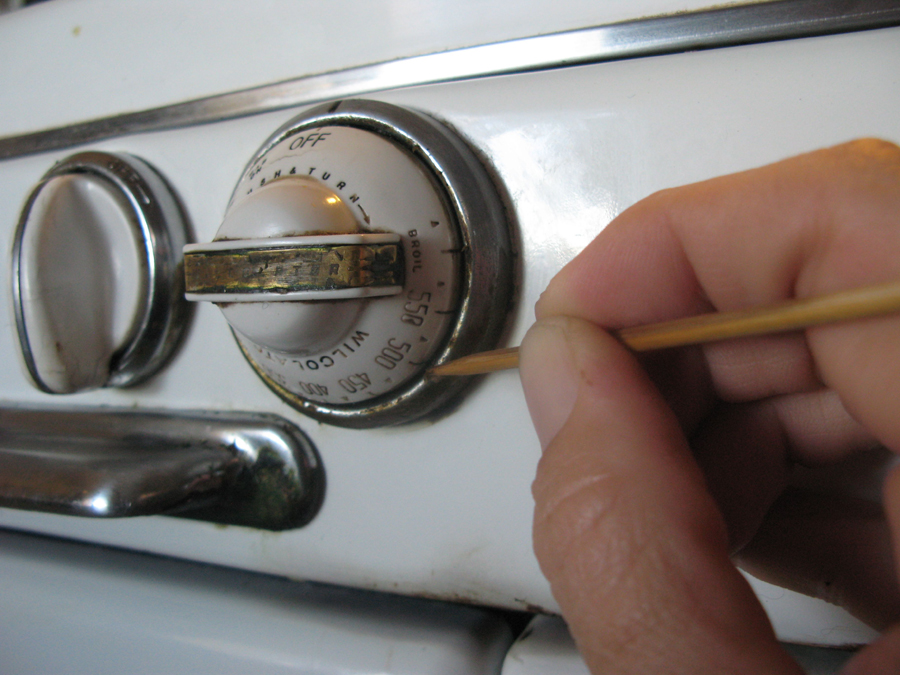New Year's Cleaning
A couple of days ago, I gave my stove the most thorough cleaning I've ever given it, or any other stove. Glen, one of the people I interviewed for Cleaning: People Talk About Housework, confessed, "It's sort of mysterious to me how somebody can make the top of a stove clean. I can wipe stuff off, but I can't scrub. It seems to me there's a gene missing." I relate to that. I categorize cleaning the stovetop with other disgusting jobs that require getting close to unidentifiable funk: mopping up the sticky substances that pool on the lower shelves of the fridge, or wiping off the crusty layer on the pedestal of the toilet.
I was expecting houseguests, so my plan was to spend three or four hours in a high intensity (but not overly thorough) clean-up of the entire house. The plan quickly veered off course when I spent two solid hours scraping and scrubbing the stove. It's a beautiful, old, white enamel stove, an O'Keefe and Merritt that I've lived with for ten years. I started with my usual cursory wipe to get rid of coffee spills and crumbs. Then I noticed the waxy brown substance oozing from behind the dials. I must see that ooze all the time, but suddenly it occurred to me that it might be possible to get rid of it. Maybe this novel thought popped into my head because it's almost the New Year, and I know that new year's cleaning is a ritual in many cultures. I was also thinking about the feng shui notion that a clean stove brings prosperity. So I tried putting some vinegar on a toothbrush to see if that would dissolve the ooze. That didn't do much. Then I soaped the dials with a warm rag and followed up by digging into the crevices with a wooden skewer that I found in a drawer next to the stove. Ribbons of brown waxy stuff peeled away on the skewer. It was quite satisfying. I felt like a dental hygienist, plying my sharp implement to free the enamel from the encasing crud.

Enamel is an amazing substance. It can last for generations and clean up to look new, with a little work. I was reminded of what Jo Ann and Richard said in their interview: "We take care of things so that they last. Our folks were that way, because they lived through the 1933 Depression. Young people today tend to want to throw things out and get something new." We've been sold this bill of goods about convenience that tells us not to be bothered to scour a pot to make sure it lasts for thirty years. Instead of "wasting time" like that, we are advised to use a disposable one. It's much more convenient. It saves time. And time equals money. But the thing is, it doesn't. It's an illusion. The money it costs to buy a new one, is much more than the time it takes to care for it. If you take care of your things, it's worth it.
My dad, who also grew up during the Depression, has had pairs of shoes for thirty years, and suits for forty years. He'd pull out his shoe polish and polish those shoes, and they looked great. And he was always telling us kids that we needed to do that. But it kind of fell on deaf ears. Fortunately for me, I have had another frugal influence in my life over the last several years: my wife Colleen Hennessey. The seventh item in her Financial Manifesto is "Clean the objects you own, rather than buying more. Wanting something new is often an illusory desire. Sometimes all that is wanted is the sheen of newness, which can be achieved by cleaning the objects you already have." Come to think of it, there are a lot of old time "make it last" values in Colleen's family: Her sister Molly de Vries is on a mission to live "a non-disposable life," creating kitchen textiles that remind us of older traditions that preceded our current throw-away culture. And another of Colleen's sisters, Mikaela, sews "moon pads," menstrual pads that can be washed and used repeatedly.
I have to admit that I felt some waves of panic during the second hour of cleaning the stove, because I felt like I was going to run out of time to get all of the other cleaning done. The deep cleaning blitz started to spread out to the areas adjacent to the stove, which I now saw with a razor vision. All that oozy stuff on the wall behind the stove. The dusty ladles hanging on the wall. The grease on the hood over the stove. It all got cleaned. But I also really enjoyed the activity, and I pondered how arbitrary it is that we classify certain activities as chores, as opposed to leisure. My loving attention to the enamel stove gave me an inkling of what it must be like to spend an afternoon polishing an antique custom car. It was satisfying. It gave me time to think. And now whenever I look at the stove's gleaming surfaces, I feel good. And a little bit more ready for a new year.
 Adele Horne Posted on
Adele Horne Posted on  Sunday, December 30, 2012 at 4:17PM
Sunday, December 30, 2012 at 4:17PM 


Reader Comments